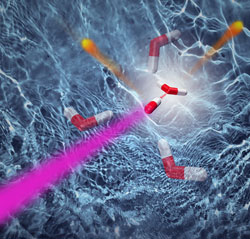| Posted: September 9, 2008 |
Scientists find new mechanism for hydrogen bonds |
|
(Nanowerk News) Water’s unrivaled omnipresence and the crucial role it plays in life drives scientists’ to understand every detail of its unusual underlying properties on the microscopic scale.
|
|
Bernd Winter and colleagues, from BESSY, Max-Born-Institut, Uppsala University, and MPI für Dynamik und Selbstorganisation, report in the current issue of Nature ("Interaction between liquid water and hydroxide revealed by core-hole de-excitation") how water solvates its intrinsic hydroxide (OH-) anion. Unraveling this behavior is important to advance the understanding of aqueous chemistry and biology.
|
 |
| Electron spectroscopy reveals that hydroxide ions can donate a hydrogen bond to water (Image: Nature) |
|
Using a resonance (photo) core-electron spectroscopy technique, with sub ten-femtosecond temporal resolution, and employing synchrotron radiation in conjunction with a liquid microjet, the researchers find that OH- is capable of donating a transient hydrogen bond to a neighboring water molecule.
|
|
Their experiment thus disproves the classical, so-called proton-hole picture, assuming that OH- is a hydrogen-bond acceptor only. The weak OH- hydrogen donor bond is responsible for a distinct intensity pattern in the electron spectra, and is connected with a unique energy transfer (intermolecular Coulombic decay) between the oxygen 1s core-excited hydroxide ion and a neighboring water molecule.
|
|
It is the first time such a process is observed in an aqueous system. To confirm that the measurements exclusively probe the weak OH- hydrogen donor bond at such high sensitivities the team has conducted comparative measurements of halide ions in water. They find that chloride and isoelectronic fluoride do not exhibit this energy-transfer channel, which corroborates recent structural diffusion models for the unusually migration of the hydroxide ion in water.
|
|
The work marks a step forward into studying very fast dynamical processes in water and aqueous solutions.
|

